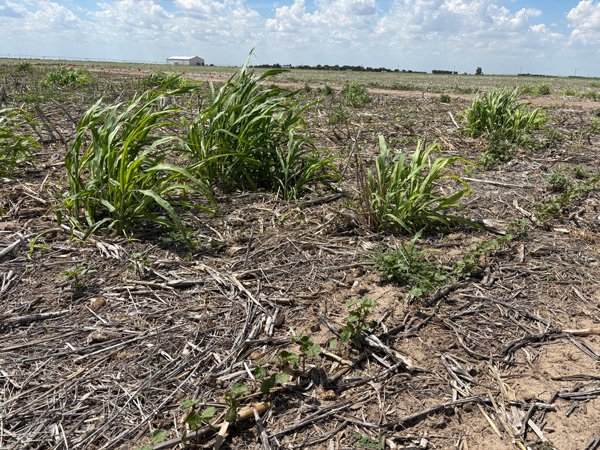In 2023, Corteva’s US cottonseed brand, Phytogen, released a new GM cotton trait package, W3E1, targeting the southwest Cotton Belt region (Kansas, Oklahoma, Texas, and New Mexico). This trait package includes WideStrike 3 for lepidopteran pest resistance as well as tolerance to Enlist One (2,4-D) and glufosinate. However, this trait package differs from the W3FE trait package Kansas cotton growers are used to in that it does not include tolerance to glyphosate. The varieties available in the 2025 growing season are PHY 136 and PHY 137. PHY 136 is an early-to-mid-maturing variety, and PHY 137 is very early maturing. Some estimate these two varieties could occupy as much as 30% of the planted acres in Kansas in 2025.
Why consider non-glyphosate-tolerant cotton?
The primary motivation for producers to try these new varieties is reduced seed costs ($100/bag savings) as the technology fee for glyphosate tolerance is omitted from the total seed cost. As seed cost is one of the greatest annual expenses in cotton production, this could be a significant cost-saving opportunity, which may be especially advantageous given current profit margins. Additionally, non-glyphosate-tolerant cotton production systems open up the opportunity for using glyphosate to control volunteer cotton in other phases of the crop rotation.
Considerations for grass and sedge control in non-glyphosate-tolerant cotton
Due to widespread glyphosate resistance in key weed species such as Palmer amaranth and kochia, the greatest weed control “loss” resulting from not spraying postemergence glyphosate will be grass control (Figure 1). However, grass control in cotton can be achieved by using Group 1 (ACCase-inhibiting) herbicides such as clethodim (SelectMax, others) or quizalofop (Assure II, others), sethoxydim (Poast), or fluazifop (Fusilade DX). Glufosinate (Liberty, others) also has activity on grasses; however, it is less effective than glyphosate or a Group 1 product.

Figure 1. An infestation of johnsongrass in a cotton field in southwest Kansas. Photo by Logan Simon, K-State Research and Extension.
In situations where glyphosate was used to control nutsedge species, trifloxysulfuron (Envoke) will provide some control. Nutsedge control will likely be improved by the addition of S-metolachlor (Dual, others) before weeds emerge.
Table 1. Grass response to selected cotton herbicides when applied according to label directions.
|
Herbicide |
Barnyardgrass |
Crabgrass |
Fall panicum |
Foxtail |
Johnsongrass (perennial) |
|
Assure II |
E |
E |
E |
E |
G-E |
|
Clethodim |
G |
E |
E |
E |
G-E |
|
InterMoc (glufosinate-resistant |
G |
G |
G |
G |
F-G |
|
Liberty and other glufosinate products (resistant cotton only) |
G |
G |
G |
G |
F-G |
|
Poast |
E |
E |
E |
E |
G |
*E=Excellent, G=Good, F=Fair, P=Poor, and – weed not listed on the herbicide label.
Glyphosate injury to non-glyphosate-tolerant cotton
An added concern in non-glyphosate-tolerant cotton production systems is the potential for glyphosate injury due to misapplication, tank contamination, and drift. When weed scientists in North Carolina sprayed 4-leaf cotton with drift rates of glyphosate, they reported a maximum of 13% yield loss following application of a 1/10 rate of glyphosate, with less than 1% yield loss caused by the 1/100 rate. However, at higher glyphosate rates (1/4 and 1/8 rates), cotton lint yield was reduced even though no visible injury was reported 7 weeks after application. Reductions were attributed to reduced boll set or delayed maturity. However, factors other than glyphosate rate can influence cotton yield loss caused by drift. Research conducted in Texas suggests that cotton yield loss is more likely when drift occurs during reproductive growth stages, and cotton yield loss was greater in high-yielding environments than locations with drought stress in the North Carolina study.
More information about weed management in cotton can be found in the “2025 Chemical Weed Control for Field Crops, Pastures, and Noncropland” guide at https://www.bookstore.ksre.ksu.edu/pubs/CHEMWEEDGUIDE.pdf or check with your local K-State Research and Extension office for a paper copy.
The use of trade names is for clarity to readers and does not imply endorsement of a particular product, nor does exclusion imply non-approval. Always consult the herbicide label for the most current use requirements.
Sarah Lancaster, Extension Weed Science Specialist
slancaster@ksu.edu
Logan Simon, Southwest Area Agronomist, Garden City
lsimon@ksu.edu
Tags: weed control cotton